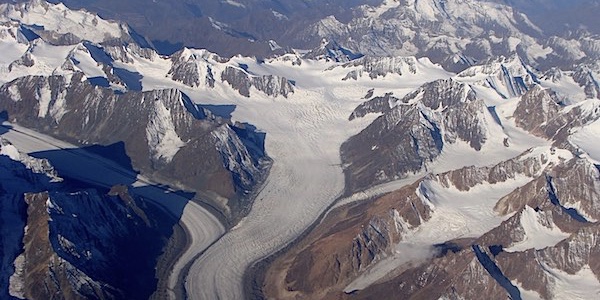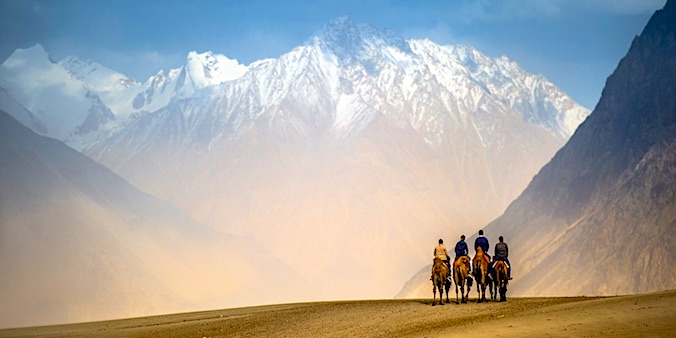LADAKH - PHYANG to HUNDAR TREK
Tour - 12 days/ 5 days trekking
PHYANG to HUNDAR TREK
Tour - 12 days/ 5 days trekking
About LADAKH
Ladakh is a part of the Indian Himalayas It is located between the Kunlun mountain range in the north and the main Himalayas to the south. Although part of India now, and earlier of the princely state of Kashmir, Ladakh has been an independent kingdom for almost 900 years.
Ladakh is well-known for its starkly beautiful mountain scenery. As a result of its location in the rain shadow of the main Himalayan Range its climate is extremely dry, and due to the high altitude – most valleys are situated at 3300m or higher – winters can be extremely cold. Summers, however, are generally pleasant if not warm and sunny. Ladakh is inhabited by a mix of Indo-Aryan and Tibetan people. Especially the latter, with their colourful buddhist culture, have given the region the nickname of ‘Little Tibet.’
Ladakh in the narrower sense is the Indus Valley with adjacent areas. It is bordered by two mountain ranges: in the northeast by the Ladakh Range, in the southwest by the Zanskar Range. The area around the capital Leh, and further upstream towards Tibet, is referred to as Upper Ladakh. Lower Ladakh is the area further downstream to Kargil, where the Indus enters Pakistan.
The remoter areas of Zanskar, Nubra and Rupshu are now seen as regions of Ladakh. In the past, these areas were sometimes part of Ladakh, sometimes not. They can be visited from Leh by car or on foot. The latter would be your means of transport, if you are up to it. Because, while jeep trips in Ladakh are very rewarding indeed, trekking will give you an even in-depth experience of the land and the people, with the added bonus of a total renovation of body and soul.
Region
Ladakh
(India)
Best Time
June end - mid October
No. Of Days
12 days,
5 days trek
Trip Character
Trekking tour
Sleeping Altitude
3050 - 4600 m.
Trip Character
Trekking tour
Level: 3
Price
INR XXX/ $ XXX
ABOUT THIS TOUR
Of the three ‘regular’ treks that used to cross the Ladakh Range from the Indus Valley to Nubra the Lasermo La trek, crossing the 5300m) high pass of the same name, is the last one remaining. The others are now partly or completely asphalted. The trek offers a lot of ‘value for money’ as it takes one in a very short time – only five days – through almost everything that a serious trek has to offer: beautiful scenery, isolated small hamlets where people still live of their animals and the land, and a high, glaciated pass that is both strenuous and rewarding.
Don’t let the short duration of this trek fool you: it is still quite tough. From the word go you’re climbing up to a high pass and there is little or no time to acclimatize – unless you plan an extra resting day at Murubak.
The cultural elements on this tour are the rich oasis of Phyang at the beginning of the tour, with the gompa at the center, and the isolated villages of Drok Yogma and Drok Gongma on day four.
In between, you’re mainly in high lying grounds where yaks and cows graze. Here you only meet shepherds and other hikers. The last day you follow a deep gorge – sometimes inside, sometimes above it – to the green village of Hundar in the Nubra Valley.
The Lasermo La trek is short but tough. The difficulty is caused by the steep build-up – as mentioned – and the height at which one sleeps. On the second day the camp is at 4600 m and on the third day you cross the Lasermo La (5440 m). After this, it is all downhill to the pleasant green village of Hundar. We give you a full day to explore Nubra Valley before you are taken back to Leh.
YOUR custom-made TRIP
The tour described here, as well as the other ones on our website, are mainly meant as suggestions. We would be happy to offer you a travel proposal that fully meets your personal demands and expectations. That means that you choose where you want to go, what level of accommodation and type of transport you want and what activities you prefer.
Please let yourself be inspired by this and other trips on our website and then drop us a line (or call us up) to explain your travel wishes. We will be happy to help you put together the perfect trip. You can reach us over e-mail, Messenger, Whatsapp or mobile phone.
EXTENSIONS & VARIATIONS
Apart from the tour as described here, you could consider the following add-ons and changes:
- After returning to Leh – or before the trek – do a 6-day exploration jeep tour to Nubra Valley, Shyok and Pangong Tso. See here.
- Do a longer or more challenging trek instead of the Lasermo La trek. For instance, the 9-day Nebuk La trek. On this trek you cross over from the Indus Valley to southeastern tip of Nubra, traversing two high passes. You end at the remote but comfortable Shyok River Lodge, after which you explore Nubra and Pangong Lake before turning to Leh (see here.) Or the more challenging 8-day high altitude trek from Rumtse to Tsomoriri. See here.
- Spend a day rafting on the Indus. There are different grades available, so there is the easy but fun to do level as well. Professional oarsmen will be with you in any case. You will be picked up from your hotel and dropped off there again at the end of the day, a pic-nic lunch is included.
ITINERARY
-
Day 1: Flight Delhi - Leh
The flight from Delhi to Leh takes only 1 hour but on a clear day, is breathtaking. Stepping down from the aircraft you may feel the altitude, but even if you don’t, it is very wise to take the rest of the day off. Stay at the hotel or at best walk around Leh bazar. Altitude 3500m. -
Day 2 & 3: In Leh
If you wake up today without a headache you may consider yourself fit to go on not too strenuous walks/excursions in and around Leh. Else it is better to stay at the hotel another day. Altitude: 3500m. -
Day 4: Leh - Phyang & Trekking Phyang - Trekking point (2 h drive, 2 - 3 h walking)
After a transfer to Phyang, you'll start you 5-day trek. Phyang is a fine example of a Ladakhi oasis with traditional farm houses, the gurgling sound of irrigation streams and a picturesque gompa (monastery) as well. The trekking crew (guide, cook and horseman) and pack horses await you here. You follow a jeep track between houses and fields to a walled poplar plantation beside a brook. Altitude 3500 → 3300 → 4050m. -
Day 5: Trekking Trekking point - Murubok (2.5 - 3.5 h)
The whole day we stick to the right bank of the main stream. Eventually the jeep track gives way to a footpath and after an old chorten we climb a dry slope and cross a brook until Murubok is reached, marked by a shepherd's hut. Altitude 3500 → 4400 → 4700m -
Day 6: Trekking Murubok - Lasermo La - Ripa (5.5 - 7.5 h)
A long, tiring day. The path crosses a large stream followed by a gradual ascent over a sometimes unclear path and loose boulders until we reach Lasermo La (5300 m). Spectacular views here of the Karakoram Range before and the Indus valley and craggy Zanskar range behind you. Descend via a large snowfield, rubble slopes, a flower meadow, peat bogs and meandering streams to the campsite. Look out for blue sheep and ibexes! Altitude 4600 → 5300 → 4700m -
Day 7: Trekking Ripa - Skarchan (5 - 6 h)
You climb over a moraine field with red-orange stones, then descend to a large valley with grasslands and hundreds of cows, yaks and goats. After crossing a bridge a good path leads to quiet Dokpa Yogma village. Hike through a side gorge, cross another bridge and descend further to the large oasis of Skarchan. Altitude 4700 → 3700m -
Day 8: Trekking Skarchan - Hundar (2.5 - 3 h)
From Skarchan, you can follow a dirt road without traffic all the way down to the main road near Hundar Pass. Here, you pass a small gompa and follow a path to Hundar. Altitude 3700 → 3130m -
Day 9: In Hundar/ Nubra
Day to spend as you like in and around Hundar. In case you want to do any excursions the management of the hotel will be most happy to assist. Altitude: 3130m. -
Day 10: Hundar - Leh (5 h)
Today you'll return to Leh, crossing the 5450m high Khardong La pass, a beautiful and spectacular drive. Altitude: 3130 → 5450 → 3500m. -
Day 11: In Leh
Day to spend as you like. In case you want to do any excursions the management of the hotel will be most happy to assist. See day 3 & 4 for suggestions. Altitude 3500m -
Day 12: Flight Leh - Delhi
After an early breakfast, the taxi will take you to the airport.
HIGHLIGHTS OF THIS TOUR
Flight to Leh


LEH
NUBRA VALLEY





